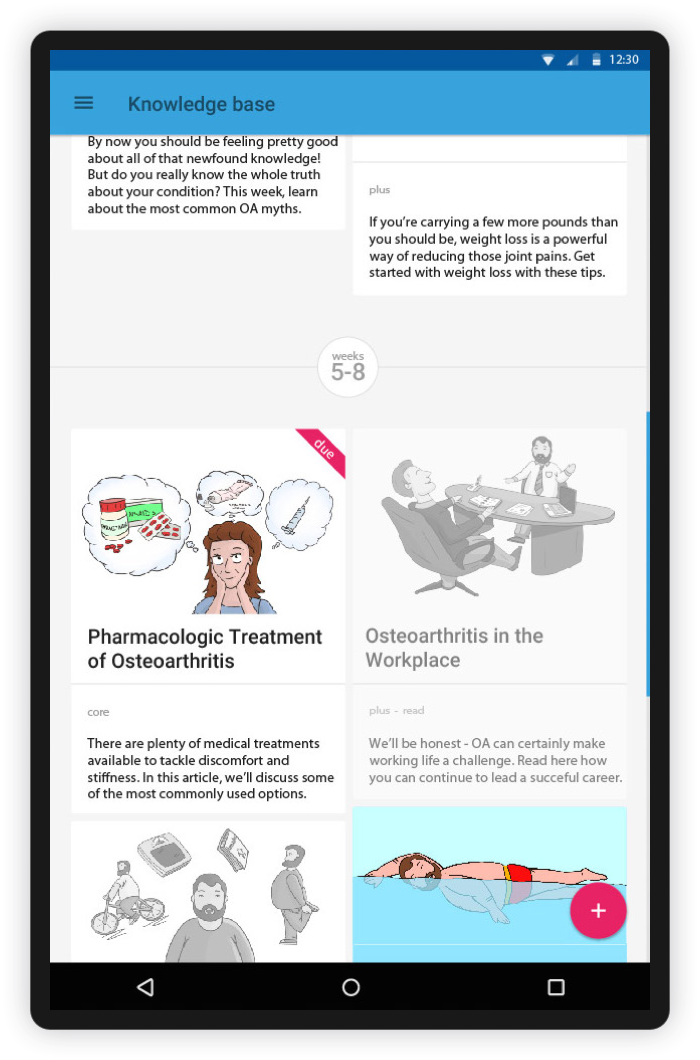HingeHealth
Digital Care for Joint Pain
HingeHealth · 2014 - 2016 · Service, Industrial, UX, UI Design
We know what's needed to fix joint pain.
We just need to get people to do it. This is why we've digitised best practice physiotherapy in an engaging and effective way.
Problem
Treatment approaches to chronic joint conditions are well understood in the medical community. However, democratized access to this knowledge and therapy is lacking, causing preventable suffering and healthcare costs.
Role
As employee #3 in this new startup, I designed the service and software to deliver care pathways to users in the comfort of their home. I also designed the hardware and set up the supply chain for device components.
Outcome
The company was able to secure multiple rounds of funding, forged partnerships with numerous major US insurers, and ultimately reduced the effects of joint conditions by 60% for thousands of people.
Ethnography
Understanding chronic joint pain
From initial research and throughout ongoing development, involving users in the process was the highest priority. While I coached the business development team in stakeholder interviews, I took my colleagues to discovery and co-creation workshops where our users could be found - at their homes and in community centres.
It also soon became clear that any solution would rely heavily on engaging users on a daily basis. This is why I deep-dived into understanding behaviour change. The result was a map of drivers of behaviour change which was used to plan targeted experiments.
Therapy, Education, Coaching
From idea to beta test in 3 months
Based on the insights gathered, I designed and user tested prototypes to address the three key pillars of delivering effective and engaging care:
A wearable sensor pair to pick up movements of users as they went through their exercises.
A digital knowledge base through which users could learn about the relationship between their lifestyle, actions, therapy, and their condition.
A community with a combination of a few ‘paired’ fellow users and professional coaches to share advice and motivation.
Hardware
Connected devices fit for the job
To enable the digitisation of physiotherapy, I designed a set of versatile motion sensors in an iterative process supported by live alpha and beta testing. Once the design was set, I set up the production and supply chain, working with producers across the UK, EU and Asia.
Design sketch of the sensor bands
3D-printing and off-the-shelf electronics components helped to rapidly create many iterations of prototypes
A preview of the final design that went into production
Photo of the injection-moulded assembly
App design
Designing for Accessibility, Fun, and Speed
The initial version of the app was designed for older demographics with inhibited fine motor skills. Larger UI elements with high colour contrast on a tablet that came with the sensors supported this.
Material Design was applied throughout for ease and speed of development.
Further Development
Scaling an idea
After initial successes with alpha users, the focus was on scaling the service, mature the design of the app, including services to distribute content and personalised coaching to users at scale. After I left the company, the design was further iterated on, maintaining the established principles of the user experience:
Legacy and Impact
A happy continuation
Not every startup becomes a success story. However, since I designed the core offering, hardware, and mobile app for HingeHealth, the team has grown to a company employing 150+ people and working with multiple major employers in the US, helping thousands of individuals to restore joint function and get back to active life.
60 %
Reduction of pain after 12 weeks for thousands of users
60 %
Fewer surgeries required, reducing the associated costs for employers
9.6 /10
Average user satisfaction
$6.2 Billion
Latest valuation of the company Hinge Health
"Being able to walk without pain has given me back my freedom and happiness."
Lenell






















